
Addiction to methamphetamines like “ice’’ was at a record high among an increased number of people seeking treatment for drug dependence, according to a major report by Odyssey House.
One of Australia’s largest rehabilitation services, Odyssey House is based in Campbelltown and treats people from around the country.
Released last Friday, the 2017 Odyssey House NSW annual report shows total admissions were up 27.5 per cent, with 789 adults entering its residential withdrawal and rehabilitation programs for alcohol and other drug dependence.
Odyssey House NSW CEO Julie Babineau said three key trends were evident during the year: continuing high levels of use of the crystal/ice form of methamphetamine; a growing proportion of older drug users seeking help; and the increased incidence of co-existing mental illness.
“One in two Odyssey House clients cited methamphetamines as their principal drug of concern, the same proportion as in 2015-16,” Ms Babineau said. “What we’re seeing now at Odyssey House is the legacy of years of serious methamphetamine problems following years of heroin problems, coupled with increasing use of methamphetamine in crystal form; ice is more potent and addictive and causes more harm than traditional powder or paste forms like speed or base.”
Overall, use of any form of methamphetamine by Australians aged 14 and older is actually declining. According to the latest National Drug Strategy Household Survey, recent use of methamphetamine declined from 2.1 per cent of respondents in the 2010 and 2013 surveys to 1.4 per cent in 2016.

However, the survey also found ice is increasingly the predominant form of methamphetamine.
In 2010, 22 per cent of methamphetamine users reported crystal/ice was the main form they used in the previous 12 months, jumping to 50 per cent of users in 2013 and 57 per cent in 2016.
“Ice can have severe negative impacts on people’s personal lives and their physical and mental health, and most find it very difficult to stop using the drug without help,” Ms Babineau said.
“Some people quickly spiral downwards, particularly when their use becomes frequent and ongoing; others may be able to sustain a relatively normal life for years before they or their families reach out for help.”
Ms Babineau said Odyssey House is also continuing to see the gradual ageing of clients seeking help.
“Now, a record seven in ten clients are over 30 years of age; only four in 10 clients were aged over 30 in 2007. Drug dependence – including ice addiction – is certainly not just a problem for young people.
“In fact, the 2016 NDSHS findings confirm that recent use of any illicit drugs has increased significantly for people in their 40s, from 11.8 per cent of respondents in 2001 to 16.2 per cent in 2016.
“It is interesting to note that methamphetamine use increased among people aged 40-49 (from 1.4 percent of respondents in the 2013 NDSHS to two percent in 2016) and remained stable at 0.6 per cent for those aged 50-59.
“The average age of ice users in Australia in 2013 was 30 years; in 2016 it was 34 years.
“This means treatment services like ours are helping greater numbers of older people struggling to overcome serious drug problems and other health issues, who may have been dependent on various substances for decades.
“For example, someone may have started drinking and smoking cannabis as a teenager, survived the heroin crisis of the 1990s and then turned to ice in the 2000s.
“Rebuilding their lives requires significant effort, time and assistance, but it’s never too late,” she said.
Although ice is a headline issue, Ms Babineau cautioned that it is just one of many drugs posing a danger.
“People with a substance use disorder often have poly-drug problems. We’re particularly concerned about the continuing risks of alcohol, heroin and misused prescription painkillers and sedatives, either alone or in potentially life-threatening combinations,” she said.
Odyssey House received approximately 35,000 enquiries during the year.
More than 40,000 people have been assisted to overcome dependence on alcohol and other drugs since Odyssey House opened its therapeutic community doors 40 years ago in 1977.



